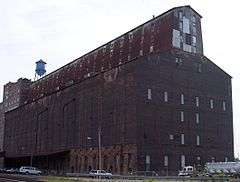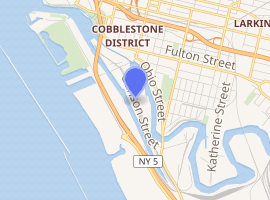Great Northern Elevator
The Great Northern Elevator is a grain storage facility at 250 Ganson Street in Buffalo, New York. The elevator is located along Buffalo's "elevator alley" and at the time of its completion in 1897, the elevator was the world's largest.[1] The mill was also one of the first to run on electricity.[2]
| Great Northern Elevator | |
|---|---|
 Great Northern Elevator, in Buffalo, NY | |

| |
| Former names | Mutual Elevator, Pillsbury Elevator |
| General information | |
| Status | Complete |
| Type | Intermediate Steel Elevator |
| Architectural style | Brick Box Silo |
| Location | 250 Ganson Street, Buffalo, NY, United States |
| Coordinates | 42.866725°N 78.87221°W |
| Construction started | March 31, 1897 |
| Completed | September 29, 1897 |
| Height | |
| Roof | 187 feet (57.0 m) |
| Design and construction | |
| Architect | Max Toltz |
| Developer | D. A. Robinson |
| Main contractor | James J. Hall, Riter-Conley |
History
The Great Northern Elevator was built by noted Chicago elevator builder D. A. Robinson. Max Toltz, a bridge engineer with the Great Northern Railroad was the consulting engineer for the building and responsible for much of the building design. The building is the last of the "brick box" type working house grain elevators still standing in North America.[3]
Ownership
- The Mutual Elevator company bought the elevator from the Great Northern Railroad in March 1903.[3]
- In 1921, a local buffalo group named the Island Warehouse Corporation purchased the building and railroad right-of-way.[3]
- The Pillsbury Company bought the elevator in 1935 and operated within the facility until 1981.[3]
- In the 1990s Archer Daniels Midland acquired the building.
Storage
The Great Northern Elevator offered a total holding capacity of 2.52 to 3 million US bushels (89,000 to 106,000 m3) in 48 large steel bins. Thirty of the bins are 38 feet (12 m) in diameter and 18 of the bins are 15.5 feet (4.7 m) in diameter. The elevator's brick exterior serves as a weather barrier and does not help to carry the weight of the cupola or the grain bins. The building's structure is supported by a web of steel I-beams.[4] The building was originally equipped with three corrugated-iron nine-story-high iron legs designed to move along tracks. These were destroyed during a storm in 1922 and replaced by two new 145-foot (44 m) marine leg towers built by the Monarch Engineering Co.[3] A concrete framed flour mill addition was erected in 1924.
Present day
In the late 1980s, then-owner Pillsbury requested a permit to raze the structure. This was opposed, and culminated in the Great Northern's designation as a city of Buffalo landmark. In 1996 and 2003 demolition of the building complex was again requested by subsequent and current owner Archer Daniels Midland (ADM). Both times it was denied.[5] The building remains one of the earliest surviving elevators in the Buffalo River District.
Gallery
- 1985 photo
 Detail of distribution chute
Detail of distribution chute Detail of Westinghouse electric motor
Detail of Westinghouse electric motor- Great Northern (mutual) elevator, looking south
.png) Survey cross section
Survey cross section Distribution level, looking north
Distribution level, looking north- Basement level, bottom of main silos
References
- "12-A Great Northern Elevator (1990)". City of Buffalo. Retrieved January 5, 2013.
- "Great Northern Grain Elevator". LaChiusa, Chuck. Buffalo as History. 2002. Retrieved January 5, 2013.
- Leary, Thomas E.; Healey, John R.; Sholes, Elizabeth C. (1991). "Great Northern Elevator" (PDF). Historic American Engineering Record. Washington, D.C.: Library of Congress. Archived from the original (PDF) on November 3, 2012. Retrieved April 24, 2014.
- "Grain Elevators - How to see them (part 2)". Buffalo History Works. Retrieved January 4, 2013.
- Licata, Elizabeth (April 2011). "Preservation-ready: The Great Northern grain elevator". Buffalo Spree. Retrieved January 4, 2013.
External links
- "Great Northern Elevator". SkyscraperPage.
- Great Northern Elevator at Emporis
- Historic American Engineering Record (HAER) No. NY-240, "Great Northern Elevator, 250 Ganson Street, Buffalo, Erie County, NY", 50 photos, 2 measured drawings, 33 data pages, 3 photo caption pages